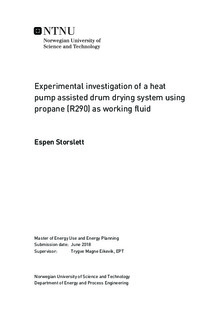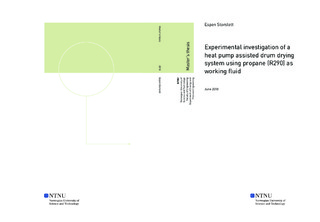| dc.description.abstract | Drum dryers has been used for drying fabric for a long time. Drying is performed by heating air causing the relative humidity to fall before blowing the heated air through wet fabric in a rotating drum. The moisture removed from the fabric can be rejected to the ambient along with the heated air or condensed to be collected or drained. Conventional drum dryer s heats air using an electric heater or combustion. This means of heating is energy consuming and requires relatively high temperatures for efficient drying.
Heat pump assisted drum dryers utilizes heat pump technology to condense the removed moisture and reheat the air in a closed loop. This technology provides higher energy efficiency and the possibility of drying at lower temperatures. Heat pump assisted drum dryers has mainly used environmental unfriendly refrigerants, such as CFC and HFC gases. The use of CFC gases has already been banned by the European Union as well as all other countries ratifying the Montreal Protocol. As HFC gases have high GWP-values they are to be banned by the EU shortly in new systems.
Due to the fact that hydrocarbons such as propane feature excellent properties as refrigerants, offer zero ODP and very low GWP they appear to be the ideal substitute for HFCs.
This thesis describes the rebuild and experimental investigation of a mass-produced heat pump assisted drum dryer utilizing the HFC gas R134a as refrigerant to utilizing propane (R290) as refrigerant. Instrumentation and sensors has been adapted to the system, and a series of experiments performed before and after the rebuild, providing an extensive documentation of system performance.
The results show that providing installation of commercially available compressors for propane, the use of propane in heat pump assisted drum dryers does not deteriorate system performance and can be implemented without excessive changes in system design. By redesigning the capillary tube, the COP of the heat pump were found to increase by 6%. | |

